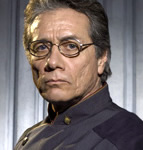Mon 21 Mar, 2011
Edward James Olmos on race as a social fiction
Comments (2) Filed under: Thinking about race, privilege and inequality| Tags: Battlestar Galactica, Edward James Olmos, Race, Racial identity, United Nations |
This week marks the second anniversary of remarks by actor and activist Edward James Olmos on the subject of race as a social fiction on a panel at the United Nations.
For the third year in a row, and as I prepare to speak tonight on a similar panel at the United Nations, I’m reposting these remarks, because I have still never heard this idea expressed with more power and conviction: the emperor has no clothes. The notion that we as a people are divided into several different races is, and always has been, a dreadful lie.
Despite the danger inherent in advocating what we might call color-blindness, what Admiral Adama of the Battlestar Galactica says here is undeniably correct, both historically and sociologically, and remains true to this day:
There is only one race … that is the human race.
So say we all!

